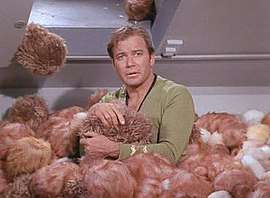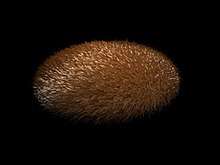Tribble
Tribbles are a fictional alien species in the Star Trek universe. They were conceived by screenwriter David Gerrold, and first appeared in a 1967 episode titled "The Trouble with Tribbles". They are depicted as a small, furry, gentle, attractive, and slow-moving but rapidly reproducing lovable species. Though they appear infrequently on-screen, they have become a popular feature of the Star Trek universe, featuring in their own eponymous official card game, and even lending their name to a conserved family of proteins that was first identified in the fruit fly as a regulator of cell division.[1][2][3]

| Tribble | |
|---|---|
| Star Trek race | |
 Captain Kirk in a pile of tribbles | |
| Also known as | Polygeminus grex, Tribleustes ventricosus |
| Information | |
| Home world | Iota Geminorum IV |
| Affiliation | None |
Representation
Tribbles were first shown in an episode of the second season of the original series, "The Trouble with Tribbles" (1967). They have appeared in several subsequent series, in brief appearances in four Star Trek films, and in video games such as Star Trek: Armada II.

According to Star Trek canon, tribbles are native to the planet Iota Geminorum IV. While they appear as small bundles of fur with no other visible features, they do produce cooing and squeaking noises. Their coloring ranges from white and grey to black, as well as speckled brown, yellow, and orange. According to Dr. Leonard McCoy's dialogue, their only two purposes in life appear to be to eat and to reproduce, and they perform both of these functions exceptionally well. McCoy concludes that tribbles use over 50% of their metabolism for reproduction and that they are born pregnant.
Due to their tendency to over-populate, Starfleet considers tribbles to be dangerous organisms and forbids their transportation. A creature genetically engineered to hunt tribbles was introduced in the animated episode "More Tribbles, More Troubles" (1973). The Klingons, in whose presence tribbles produce a convulsive, shrieking reaction, consider them "mortal enemies", as stated in the Star Trek: Deep Space Nine episode "Trials and Tribble-ations" (1996).
The Star Trek: Short Treks episode "The Trouble with Edward" reveals that tribbles were not originally "born pregnant", and in fact their reproductive rate was exceedingly slow. A Starfleet scientist, Edward Larkin, genetically engineered them into their current form, in an attempt to solve a planetary food shortage. The experiment went disastrously wrong, resulting in Larkin's death, the destruction of his ship (overrun by tribbles), and the subsequent evacuation of the planet they were trying to save. Also, some tribbles managed to reach Klingon space, also with disastrous results. [4]
Origin
David Gerrold has written that his original idea for tribbles was based on the well-known parts associated with the overpopulation of rabbits in Australia. He wanted a creature prop that would be cheap to produce and took inspiration from a ball of pink fuzz attached to a key ring. The name for tribbles was originally "fuzzies," but to avoid confusion with the 1962 H. Beam Piper novel Little Fuzzy, Gerrold brainstormed some nonsense words, arriving at "tribble".
Shortly before the episode was produced Kellam de Forest Research pointed out the similarities between Gerrold's creatures and the martian flat cats from Robert A. Heinlein's novel The Rolling Stones (1952),[5] and recommended purchasing the rights to the novel. Instead, Star Trek producer Gene L. Coon contacted Heinlein by telephone and asked that he waive the similarity. Heinlein did, but later regretted the decision when the Star Trek franchise continued to use tribbles in their productions.
Gerrold discusses the matter of potential inadvertent plagiarism in his 1973 book, The Trouble with Tribbles, but he does not admit to it. He claims that instead of money or credit, Heinlein asked only for a signed copy of the script, and that afterwards Heinlein wrote to him dismissing the similarity, “we both owe something to Ellis Parker Butler...and possibly to Noah.”[6] However, Gerrold's account does not agree entirely with Heinlein's own recollection of the matter as related in private correspondence cited in his authorized autobiography.[7]
Reception
In 2007, WIRED magazine noted the Tribbles, as one of the top ten classic, cheesy creatures of Star Trek.[8]
References
- Tribbles entry on Interactive Fly database
- Hegedus Z; Czibula A; Kiss-Toth E (2007). "Tribbles: a family of kinase-like proteins with potent signalling regulatory function". Cellular Signalling. 19 (2): 238–250. doi:10.1016/j.cellsig.2006.06.010. PMID 16963228.
- Seher, T. C.; Leptin, M. (2000-06-01). "Tribbles, a cell-cycle brake that coordinates proliferation and morphogenesis during Drosophila gastrulation". Current Biology. 10 (11): 623–629. doi:10.1016/s0960-9822(00)00502-9. ISSN 0960-9822. PMID 10837248.
- "Short Treks: Season 2 Episode 2: The Trouble With Edward Easter Eggs". Den of Geek. October 10, 2019. Retrieved October 11, 2019.
- David Gerrold (1973). Trouble with Tribbles: The Birth Sale and Final Production of One Episode. ISBN 0345234022.:p.271
- David Gerrold (1973). Trouble with Tribbles: The Birth Sale and Final Production of One Episode. ISBN 0345234022.:p.274
- Patterson, William H. (2016). Robert A. Heinlein, Vol 2: In Dialogue with His Century Volume 2: The Man Who Learned Bette. Tor Books. pp. 290, 291. ISBN 0765319632.
If that matter had simply been dropped after that one episode was filmed, I would have chalked it up wryly to experience. But the "nice kid" did not drop it; "tribbles" (i.e. my "flat cats") have been exploited endlessly… Well that’s one that did "larn me." Today if J. Christ phoned me on some matter of business, I would simply tell him: "See my agent.
- Sjoberg, Lore (2007-12-19). "Star Trek's 10 Cheesiest Classic Creatures". Wired. ISSN 1059-1028. Retrieved 2019-06-08.
External links
- Tribble at Memory Alpha (a Star Trek wiki)
- Tribble article at official site, StarTrek.com
